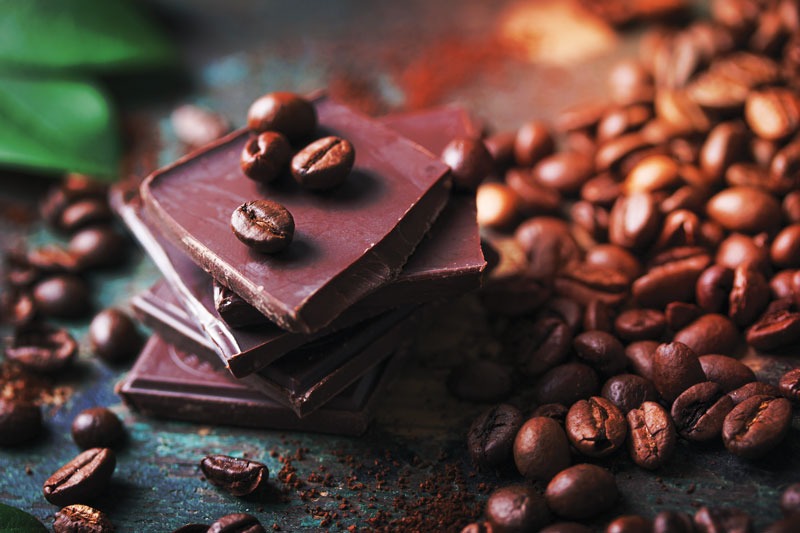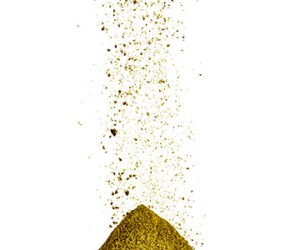Infusing Chocolate and Coffee to Your Brew
Bière a la café mocha
There’s little in the way of flavors that a brewer can’t add to their beer these days. The seemingly endless variety of candy, fruit, and other flavors that you can find in Goses and pastry stouts proves the point. But sometimes the classics are still the best and when you have your fill of sour mango cheesecake, you can always find the warm hug of coffee and chocolate.

Often used to enhance roast characteristics found in darker beers, both coffee and chocolate have found their way into lighter beers too. Photo courtesy of Shutterstock.com
These two exotic flavors, along with their somehow labeled “plain jane” cousin — vanilla — have been barn burner sensations since their introductions into Western cuisine. In beer, that truth still holds!
What Do We Want from Coffee and Chocolate?
This becomes one of those problems of, “how do you describe the color blue?” What do we want? Well, the flavors of coffee and chocolate. The flavors of dark bite-y roast with sweet berries and cherries, earthy and leathery tones.
Because you’re adding these flavors to a large batch of other flavors, you want to make sure you’re adding potent punches of coffee or chocolate (or both). This is not a time for subtlety. We’d also suggest you avoid getting spendy with your ingredients. Invest in good quality, but don’t go overboard with your expense. (Save the really expensive stuff for separate enjoyment.)
Form Factors
As with any fundamental foodstuff, there are endless form factors available to us and each choice impacts the flavors that you’ll get.
Coffee Forms
Whole beans: Coffee in its purest form and easy to use. We recommend using them like you would dry hops. One of Drew’s favorite applications is from his friend, Kevin Baranowski, who serves a sweet stout on draft through a Randall with whole-bean for an intense last-minute hit of coffee.
Grounds: Mostly used in the kettle or to make brew for additions — Drew finds that if you add the grounds to the kettle, they’re best added off the boil as a whirlpool addition to avoid extracting additional bitterness.
Instant: Added to the fermenter, a decent quality powdered coffee provides a quick jolt with minimum fuss.
Brewed/espresso: Drew’s favorite way of adding coffee flavor is to use a strong brewed coffee. (Drew uses cold brew coffee concentrate as a way of adding potent flavor without adding a ton of water.)
Chocolate Forms
Cacao nibs: The root of chocolate, little nuggets of fermented, but unprocessed cacao beans. You can buy them raw or roasted. They provide more of the deep earthy flavors.
Cocoa powder: The intense essence of chocolate, but a real pain to incorporate outside of the kettle. Neither of us are generally a fan of cocoa powder, both for its difficulty to dissolve in beer and in flavor prediction.
Solid chocolate: The final product of an amazing amount of work by chocolatiers. Because the cocoa butter is incorporated with the product, we’re generally not in favor of using this. (That includes baking chocolates like Baker’s German’s Baking Bars.)
Liqueurs and Extracts
There are many different concentrated forms of coffee and chocolate flavors in these forms. Usually, we don’t favor extracts that we don’t make ourselves because we prefer to control the ingredients and Denny particularly objects to the heat of alcohol in many commercially purchased tinctures.
Having said that, many brewers find success with these products and they are an easy way to inject flavor to your beer by simply adding them to the finished beer. Beware of the added sugar content and what they can do with refermentation in the package.
Some Things to Watch Out For
As with all ingredients, coffee and chocolate both carry negatives that we need to account for when using these components. The first is that both contain oils that can be detrimental to the foamy collar that we desire in our pints. Handling fresh coffee beans, the oils are clearly visible on the bean’s surface. And chocolate obviously contains an extraordinary amount of fat.
We’ll cover how to deal with the fat in chocolate on later in this article and we usually don’t worry about the oil from coffee . . . it just is what it is.
Because you’re adding these flavors to a large batch of other flavors, you want to make sure you’re adding potent punches of coffee or chocolate (or both).
To us, the more important bit is remembering and adjusting for the bitterness and tannic bite that chocolate and coffee can impart. This is where tasting comes into play. With coffee, we’d recommend making a strong brew with your choice of coffee and blend it with a representative beer of the style you want to make (or one you’ve already made).
Chocolate is tricky because the flavors are hard to predict until you actually add them. (We’ll address that in a moment as well), but if you use cacao nibs you must be aware that exposure time will change your flavors drastically. Chocolate contributes its positive flavors quickly without a need for long soak times.
The Best Way to Add Your Flavors
As we’ve stated many times over our columns here in BYO (and other writings), we’re generally fans of processes that give us both more flexibility and assurance of the final product. Generally, that means additions as late in the process as we can so we can adjust our additions to the flavor of the beer we produced and not the one we thought we were making.
It’s important to know the structure of the beer that we’re flavoring so we can choose important characters and adjust flavoring amounts to the beer in the glass. Plus, doing it this way allows you more beer variety if you leave a beer half “plain” and half “flavored.”
So yes, the column is nominally about chocolate and coffee, but the reality is that whatever flavor you’re adding, use this as a guide! (This is a place where most professional brewers have a real advantage – they have more beer to play with and have more repeatable experiences with their beers and flavorings.)
Process for Tasting the Beer and Flavoring
If you’re doing a post-fermentation addition (i.e., adding it for bottling or kegging), we recommend this process to fine-tune the amount to add:
– Pour a measured sample of the beer into a glass (example, a 12 oz./355 mL pour of stout).
– Measure a small amount of your flavoring (example, ¼ oz./7 mL of extract).
– Mix the flavoring into the beer and evaluate. Assess where you’re at on the spectrum. Do you need more? Do you need less? Right in the Goldilocks zone?
– Make another adjusted sample, if needed. (We usually only need the one and adjust from there.)
– Determine the amount of beer to be flavored. Say you have 4.5 gallons (17 L) remaining after racking off the yeast. That’s 576 oz. (17,000 mL) or 48 of your example 12-oz. (355-mL) glasses. If your ¼ oz. (7 mL) was on the money, that means you need to add 12 oz. (355 mL) of your flavor to the beer to recreate the experience.
– Add the flavor to the bottling bucket or keg and make sure it gets evenly mixed into solution.
Chocolate Tips
When it comes to chocolate, Drew really prefers to use cacao nibs as they’re less processed and more complex without added sugars and a manageable fat content. (And these days you can find nibs in just about any good grocery store — which you couldn’t say 10 years ago.)
There are two primary ways to use the nibs. You can treat them like dry hops and add them directly to the secondary or keg, or brewers can create a tincture/extract with them. If you plan to add them like a dry hop, a hop bag is recommended to contain the nibs. Keep an eye on this though — too much time and the beer will begin to extract tannic/astringent character from the nibs. Unless you like that mouth-puckering drying sensation, we recommend checking the beer around day four of aging and removing the nibs from the beer when you get the flavor you want.
Drew accidentally left a beer with nibs in a keg for two or so weeks once. The chocolate porter was so puckeringly astringent that it was rendered undrinkable. Not one to waste a beer — Drew added a full bottle of Razzmatazz liqueur to the keg, gave it a shake and the beer settled into a wonderfully balanced chocolate raspberry cordial porter. The keg was promptly drained at a party before the sugar got fermented.
If you want to use an extract, Drew tends to make his own to control the flavor and strip the fat. (He has a whole cabinet of various flavored tinctures that he makes for fun.) At the strength he normally makes, it takes about 3 oz. (90 mL) in a 5-gallon (19-L) batch to achieve a strong but not obnoxious chocolate presence. Here’s the recipe:
Basic Cacao Nib Tincture
Creates 6 oz. (175 mL) of extract
- 6 oz. (175 mL) vodka
- 3 oz. (85 g) cacao nibs (roasted or raw)
- Mix the vodka and cacao nibs in a tight sealing jar like a jelly jar or mason jar. Shake every day, several times, for 4 days.
- Strain the nibs out of the dark extract. Discard.
- Place the extract in the freezer overnight.
- In the morning, carefully scrape out the fat cap of cocoa butter and discard. Remove any remaining bits and then store the extract for up to a year.
If you prefer to use cocoa powder (since the fat is removed), grab a good quality cocoa powder and use about 8 oz. (230 g) in the kettle near the end of the boil. Be warned, there will probably be a bit of scrubbing afterwards from the mess left behind since it doesn’t dissolve and sets like mud. And please, no Hershey’s chocolate syrup. Just look at the ingredients list for our reasoning there.
Coffee Tips
Coffee we’re not as strict about the whole “not in the kettle” thing, but it’s still generally a good guideline. Our favorite way is to simply brew up really strong coffee and use that in the beer. In general, the less heat the coffee sees during the extraction, the better. We’ve seen recipes where someone goes to a coffee shop, buys 12 shots of espresso and adds it to the kettle. The espresso is a good idea, but the kettle will be brutal to any of the less overt characters.
• Drip coffee — it’s your standard joe, but for the purposes of beer making, it’s fairly weak and watery.
• Espresso — dark, roasty, and bitter. This is what you use when you want the coffee to read like “coffee!” and carry a bite. If you structure the beer to deal with any harshness, this can be the way to really drive home the coffee point.
• Cold brew coffee — now available at your grocery store, coffee that never sees heat as part of the brewing process. The flavor is different, both more intense and more mellow, less acidic. Be aware in the store, you’ll often see “cold brew” coffee in a ready to drink format. For brewing purposes, Drew prefers to use (or make) a cold brew concentrate. (Use about 1:3 of coarse ground coffee-to-water and let it sit overnight before straining — so 1 cup of coffee bean grounds to 3 cups of cold, filtered water).
If you want to brew with kettle coffee, Drew actually prefers adding about a cup of fresh grounds in the mash. You’ll get a coffee kick, but you’ll lose a lot of the nuance, but who needs nuance if you’re dropping coffee into your latest Russian imperial stout at 12.5% ABV?



